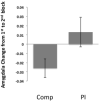Indiscriminate amygdala response to mothers and strangers after early maternal deprivation
- PMID: 23810622
- PMCID: PMC3818506
- DOI: 10.1016/j.biopsych.2013.05.025
Indiscriminate amygdala response to mothers and strangers after early maternal deprivation
Abstract
Background: In altricial species, maternal stimuli have powerful effects on amygdala development and attachment-related behaviors. In humans, maternal deprivation has been associated with both "indiscriminate friendliness" toward non-caregiving adults and altered amygdala development. We hypothesized that maternal deprivation would be associated with reduced amygdala discrimination between mothers and strangers and increased parent report of indiscriminate friendliness behaviors.
Methods: Sixty-seven youths (33 previously institutionalized; 34 comparison; age-at-scan 4-17 years) participated in a functional magnetic resonance imaging experiment designed to examine amygdala response to mother versus stranger faces. In-scanner behavior was measured. Indiscriminate friendliness was assessed with parental report.
Results: Comparison youth showed an amygdala response that clearly discriminated mother versus stranger stimuli. Previously institutionalized youths, by contrast, exhibited reduced amygdala discrimination between mothers and strangers. Reduced amygdala differentiation correlated with greater reports of indiscriminate friendliness. These effects correlated with age-at-adoption, with later adoptions being associated with reduced amygdala discrimination and more indiscriminate friendliness.
Conclusions: Our results suggest that early maternal deprivation is associated with reduced amygdala discrimination between mothers and strangers, and reduced amygdala discrimination was associated with greater reports of indiscriminate friendliness. Moreover, these effects increased with age-at-adoption. These data suggest that the amygdala, in part, is associated with indiscriminate friendliness and that there might be a dose-response relationship between institutional rearing and indiscriminate friendliness.
Keywords: Affective salience; amygdala development; attachment; indiscriminate friendliness; institutional rearing; maternal deprivation.
Copyright © 2013 Society of Biological Psychiatry. All rights reserved.
Conflict of interest statement
Financial Disclosures: All authors report no biomedical financial interests or potential conflicts of interest.
Figures





Comment in
-
Unraveling the longstanding scars of early neurodevelopmental stress.Biol Psychiatry. 2013 Dec 1;74(11):788-9. doi: 10.1016/j.biopsych.2013.10.004. Biol Psychiatry. 2013. PMID: 24188696 No abstract available.
References
-
- Rutter M, O’Connor TG. Are there biological programming effects for psychological development? Findings from a study of Romanian adoptees. Dev Psychol. 2004;40:81–94. - PubMed
-
- Insel TR, Young LJ. The neurobiology of attachment. Nat Rev Neurosci. 2001;2:129–136. - PubMed
-
- O’Connor TG, Cameron JL. Translating research findings on early experience to prevention: animal and human evidence on early attachment relationships. Am J Prev Med. 2006;31:S175–181. - PubMed
-
- Bowlby J. The effect of separation from the mother in early life. Ir J Med Sci. 1954:121–126. - PubMed
Publication types
MeSH terms
Grants and funding
LinkOut - more resources
Full Text Sources
Other Literature Sources

